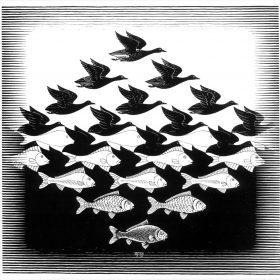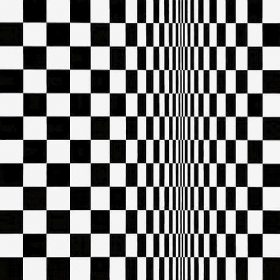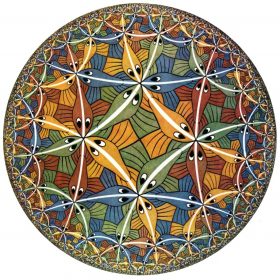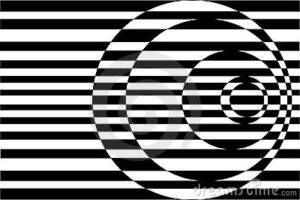Op art- Definition
Op art, also known as optical art, is a distinctive artistic movement originating in the 1960s. It encompasses the use of optical illusions, geometric patterns, and contrasting hues to elicit a sensation of motion, depth, and vibrancy within two-dimensional compositions. By captivating viewers’ perception, Op art presents a visual challenge, enticing an interactive and dynamic visual encounter.
Op art- Overview
Actually, this article describes everything about Op art. But still, if you want to know more things about Op art, then you should read our two categories– “Geometric abstraction” and “Optical illusions.”
You would know these things in this article:- The Responsive Eye, Black-and-white and the figure-ground relationship & Color interaction.
And if you want to know more things (About the Op art movement). Then check our- People also search (Op art) for section.
A category such as “Geometric abstraction,” describes the various aspects, and Category “Optical illusions” gives information about other things.
MORE 6 LINES
Op art- 4 Frequently asked questions
1. Can you explain the history of Op art?
Date of the emergence of this art movement is- 19th century. “Sky and Water,” “Movement in Squares” (So-called artworks) define the history of this art style, these are Op art artworks.
There are some artists such as Richard Anuszkiewicz, Victor Vasarely, and Bridget Riley who contributed to the renaissance of Op art movement.
Paintings/artworks that are part of OP ART history
Top 3 Artworks
Sky and Water:-
Movement in Squares:-
Circle Limit:-
Top 5 Artists
1st Victor Vasarely:-
Notable works:- Own workshop & Tribute to Malevitch (1954).
Qualification:- Workshop (Hungarian-French artist).
2nd Bridget Riley:-
Notable works:- Shadow Play, 1990 & Bridget Riley, Bolt of Colour, 2017-2019.
Qualification:- Goldsmiths College, Royal College of Art (English painter).
3rd Jesus Rafael Soto:-
Notable works:- Brussels Mural, Jesús Soto (1958) & Penetrable amarillo. Museo Soto, Ciudad Bolivar.
Qualification:- School of Plastic and Applied Arts (Venezuelan op and kinetic artist).
4th Richard Anuszkiewicz:-
Notable works:- Cleveland Institute of Art in Cleveland & National Academy of Design.
Qualification:- Cleveland Institute of Art (American painter, printmaker, and sculptor).
5th Jean Pierre Yvaral:-
Notable works:- School of Applied Arts in Paris between 1950 & Visual Art Research Group.
Qualification:- School of Applied Arts, Paris (French artist working in the fields of op-art).
2. What were some of the characteristics of the Op art period?
In 1955, for the exhibition Mouvements at the Denise René gallery in Paris, Victor Vasarely and Pontus Hulten promoted in their “Yellow manifesto” some new kinetic expressions based on optical and luminous phenomenon as well as painting illusionism. The expression kinetic art in this modern form first appeared at the Museum für Gestaltung of Zürich in 1960, and found its major developments in the 1960s. In most European countries, it generally includes the form of optical art that mainly makes use of optical illusions, like op art, as well as art based on movement represented by Yacov Agam, Carlos Cruz-Diez, Jesús Rafael Soto, Gregorio Vardanega or Nicolas Schöffer.
3. Who would be considered the ‘Father’ of Op art?
If you analyze the biography of Op art artists and Op art artworks, then you would get that there is no fixed answer to this question.
If you are the Op art student, then you must have seen differences in paintings such as “Metamorphosis,” “Sky and Water,” “Circle Limit,” “Three Worlds,” and “Movement in Squares.”
Along with it, if you analyze the biography of Op art artists such as Jean Pierre Yvaral, Victor Vasarely, Jesus Rafael Soto, Richard Anuszkiewicz, and Bridget Riley.
Then it would be very difficult to say.
Because, altogether, their contribution to the renaissance of Op art movement is huge and these are counted among the elite class in Op art history.
That’s why there is no fixed answer.
4. What are some of the most expensive pieces of Op art ever created?
VICTOR VASARELY is obviously number 1 Op art artist. And the artworks of this artist (“Three Worlds,” and “Movement in Squares” including others) remain in high demand. And these artworks are counted in most expensive pieces of Op art created.
Along with it, you may select our- Victor Vasarely art-Top 25 designs, paintings, photos, prints, and sculptures.
Although, Richard Anuszkiewicz, Jesus Rafael Soto, and Bridget Riley are also a very renowned name in this category. Their Op art artworks are also very expensive.
Op art- Top 4 Famous Paintings
1. Sky and Water I
Artist: Maurits Cornelis Escher
Created: June 1938
Period: Op art
Dimensions: 43.5 cm × 43.9 cm
(17.1 in × 17.3 in)

2. Movement in Squares
Artist: Bridget Riley
Created: 1961
Period: Op art
Genre: Abstract art

3. Circle Limit III
Artist: Maurits Cornelis Escher
Created: 1959
Period: Op art

4. Three Worlds (Escher)
Artist: Maurits Cornelis Escher
Created: December 1955
Period: Op art
Dimensions: 36.2 cm × 24.7 cm (14.3 in × 9.7 in)

Op art- Characteristics
If you want to know the characteristics of Op art along with Magic realism, Abstract expressionism, and Abstract art.
So here are two categories 1. (Geometric abstraction) and 2. (Optical illusions) that explain the various aspects of this art movement.
First category “Geometric abstraction” explains the deepness of this art movement and,
Second category “Optical illusions” describes the artistic aspect of this art movement.
There are very famous artworks such as – “Sky and Water,” “Movement in Squares,” “Circle Limit.” If you observe the artworks of Op art, then you can easily guess the characteristics of it.
And also other paintings such as “Three Worlds” and “Metamorphosis” describe the characteristic of it.
MORE 6 LINES
Op art- People also search for
| Top artists (5) | Top artworks (5) |
|---|
Op art- Other art movements
Abstract art
Abstract expressionism
Magic realism
Op art- Relation with other art movements.
Op art has been the part of art history, which artists such as Victor Vasarely, Bridget Riley, and Jesus Rafael Soto have contributed to a great extent to make it art movement.
Op art has given many other renowned artists such as Richard Anuszkiewicz, Jean Pierre Yvaral, etc. Op art is an art movement of art lovers because Op art is a pastiche of many different art styles such as Abstract art, Abstract expressionism, Magic realism, etc.
In this article, you would get information about other art movements also such as;
Abstract art
Abstract expressionism
Magic realism
If you (As a/an Op art student) see the artworks of these art movements, specifically Abstract art and Abstract expressionism, then definitely you would get small similarity.
Indeed, Op art is a pastiche of many art movements due to its artists.
Op art has a complicated history (Relation of artists of Op art), and its specific and precise definition (Of Op art) has been the subject of debate.
That’s why, in the realm of art, craft, and aesthetics, the definition of Op art is different. But don’t worry; this website (artandcrafter.com– Victor Vasarely + Op art) has covered all aspects.




